Oracle With 语句语法及示例
oracle中with递归的用法
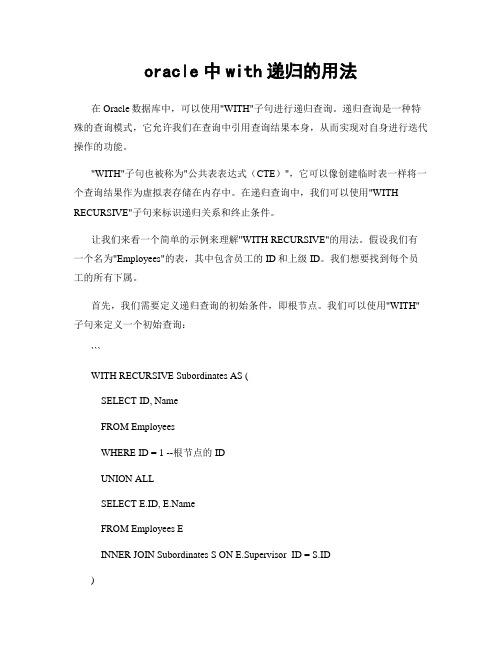
oracle中with递归的用法在Oracle数据库中,可以使用"WITH"子句进行递归查询。
递归查询是一种特殊的查询模式,它允许我们在查询中引用查询结果本身,从而实现对自身进行迭代操作的功能。
"WITH"子句也被称为"公共表表达式(CTE)",它可以像创建临时表一样将一个查询结果作为虚拟表存储在内存中。
在递归查询中,我们可以使用"WITH RECURSIVE"子句来标识递归关系和终止条件。
让我们来看一个简单的示例来理解"WITH RECURSIVE"的用法。
假设我们有一个名为"Employees"的表,其中包含员工的ID和上级ID。
我们想要找到每个员工的所有下属。
首先,我们需要定义递归查询的初始条件,即根节点。
我们可以使用"WITH"子句来定义一个初始查询:```WITH RECURSIVE Subordinates AS (SELECT ID, NameFROM EmployeesWHERE ID = 1 --根节点的IDUNION ALLSELECT E.ID, FROM Employees EINNER JOIN Subordinates S ON E.Supervisor_ID = S.ID)```在上面的例子中,我们选择ID为1的员工作为根节点,并将其放入一个名为"Subordinates"的递归查询中。
然后,我们使用UNION ALL将根节点的下属与子查询的结果连接起来,形成一个递归关系。
接下来,我们需要选择递归查询的结果。
在这个例子中,我们只需选择最终结果,即所有下属的姓名:```SELECT NameFROM Subordinates;```这样,我们就得到了根节点下的所有员工的下属姓名。
需要注意的是,在递归查询中,我们必须保证递归路径是有限的,并且存在终止条件,否则查询将无限循环。
Oracle With语句用法
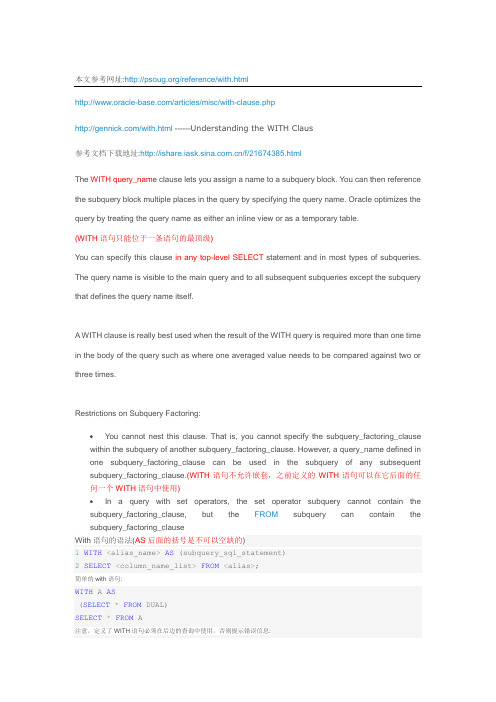
本文参考网址:/reference/with.html/articles/misc/with-clause.php/with.html ------Understanding the WITH Claus参考文档下载地址:/f/21674385.htmlThe WITH query_nam e clause lets you assign a name to a subquery block. You can then reference the subquery block multiple places in the query by specifying the query name. Oracle optimizes the query by treating the query name as either an inline view or as a temporary table.(WITH语句只能位于一条语句的最顶级)You can specify this clause in any top-level SELECT statement and in most types of subqueries. The query name is visible to the main query and to all subsequent subqueries except the subquery that defines the query name itself.A WITH clause is really best used when the result of the WITH query is required more than one time in the body of the query such as where one averaged value needs to be compared against two or three times.Restrictions on Subquery Factoring:∙You cannot nest this clause. That is, you cannot specify the subquery_factoring_clause within the subquery of another subquery_factoring_clause. However, a query_name defined in one subquery_factoring_clause can be used in the subquery of any subsequent subquery_factoring_clause.(WITH语句不允许嵌套,之前定义的WITH语句可以在它后面的任何一个WITH语句中使用)∙In a query with set operators, the set operator subquery cannot contain the subquery_factoring_clause, but the FROM subquery can contain the subquery_factoring_clauseWith语句的语法(AS后面的括号是不可以空缺的)1WITH<alias_name>AS (subquery_sql_statement)2SELECT<column_name_list>FROM<alias>;简单的with语句:WITH A AS(SELECT*FROM DUAL)SELECT*FROM A注意,定义了WITH语句必须在后边的查询中使用,否则提示错误信息:1WITH A AS2 (SELECT*FROM DUAL)3SELECT*FROM dual(错误的原因是因为没有使用定义的WITH语句进行查询)两个with语句的语法:1WITH<alias_one>AS2 (subquery_sql_statement),3<alias_two>AS4 (sql_statement_from_alias_one)5SELECT<column_name_list>6FROM<alias_one>, <alias_two>7WHERE<join_condition>;测试例子:1WITH A AS2 (SELECT*FROM DUAL),3 B AS4 (SELECT*FROM DUAL)5SELECT*FROM B, A当在FROM关键子后面没有全部使用定义的WITH语句,他就会提示同上的错误信息: (不可引用在with子句中定于的查询)在视图中使用WITH语句进行连接:1CREATE OR REPLACE VIEW WITH_V AS2WITH DEPT_V AS (SELECT*FROM DEPT),3 EMP_V AS (SELECT*FROM EMP)4SELECT D.DNAME,D.LOC,E.*FROM EMP_V E5LEFT JOIN DEPT_V D6ON D.DEPTNO = E.DEPTNO使用WITH AS 语句可以为一个子查询语句块定义一个名称,使用这个子查询名称可以在查询语句的很多地方引用这个子查询。
oracle with as 原理
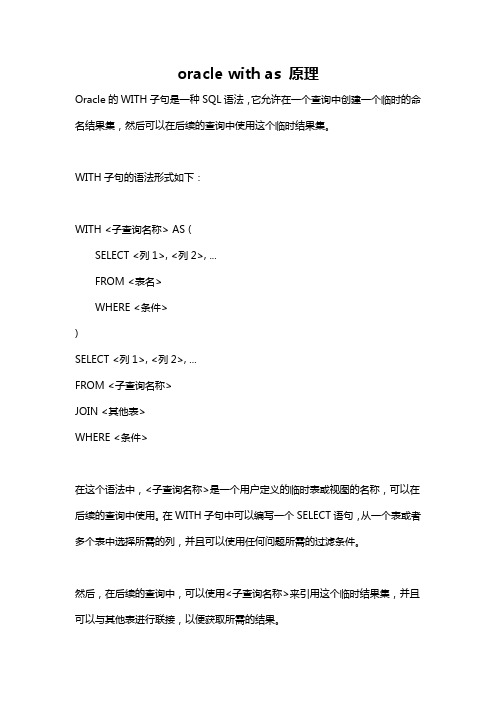
oracle with as 原理
Oracle的WITH子句是一种SQL语法,它允许在一个查询中创建一个临时的命名结果集,然后可以在后续的查询中使用这个临时结果集。
WITH子句的语法形式如下:
WITH <子查询名称> AS (
SELECT <列1>, <列2>, ...
FROM <表名>
WHERE <条件>
)
SELECT <列1>, <列2>, ...
FROM <子查询名称>
JOIN <其他表>
WHERE <条件>
在这个语法中,<子查询名称>是一个用户定义的临时表或视图的名称,可以在后续的查询中使用。
在WITH子句中可以编写一个SELECT语句,从一个表或者多个表中选择所需的列,并且可以使用任何问题所需的过滤条件。
然后,在后续的查询中,可以使用<子查询名称>来引用这个临时结果集,并且可以与其他表进行联接,以便获取所需的结果。
使用WITH子句的好处是可以将一个复杂的查询分解为多个更简单的子查询,并且可以更直观地理解查询的逻辑。
此外,WITH子句还可以提高查询的性能,因为它允许数据库引擎在执行查询之前计算结果集,并将其存储在一个临时表中,以供后续的查询使用。
这样可以避免多次执行相同的子查询,从而减少了查询的执行时间。
OracleWITH语法解析
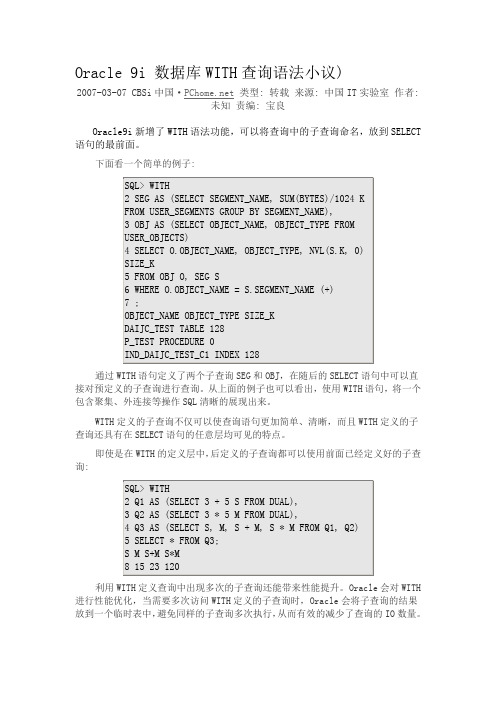
Oracle 9i 数据库WITH查询语法小议)2007-03-07 CBSi中国·类型: 转载来源: 中国IT实验室作者:未知责编: 宝良Oracle9i新增了WITH语法功能,可以将查询中的子查询命名,放到SELECT 语句的最前面。
下面看一个简单的例子:通过WITH语句定义了两个子查询SEG和OBJ,在随后的SELECT语句中可以直接对预定义的子查询进行查询。
从上面的例子也可以看出,使用WITH语句,将一个包含聚集、外连接等操作SQL清晰的展现出来。
WITH定义的子查询不仅可以使查询语句更加简单、清晰,而且WITH定义的子查询还具有在SELECT语句的任意层均可见的特点。
即使是在WITH的定义层中,后定义的子查询都可以使用前面已经定义好的子查询:利用WITH定义查询中出现多次的子查询还能带来性能提升。
Oracle会对WITH 进行性能优化,当需要多次访问WITH定义的子查询时,Oracle会将子查询的结果放到一个临时表中,避免同样的子查询多次执行,从而有效的减少了查询的IO数量。
看一个简单的例子,首先构造一张大表,现在要取出大表中ID最小、ID最大以及ID等于平均值的记录,看看普通写法和WITH语句的区别:为了避免第一次执行时物理读的影响,查询结果选取了SQL的第三次运行,物理读为0时的统计信息。
观察执行计划可以看到,先后对T_WITH表进行了4次全表扫描,并产生了5529个逻辑读。
下面看看WITH语句的表现:观察这次的执行计划,发现只对T_WITH表进行了两次全表扫描,而从逻辑读上也可以观察到,这次只产生了2776的逻辑读,正好是上面不使用WITH语句的一半。
通过分析执行计划,Oracle执行了WITH子查询一次,并将结果放到了临时表中,在随后对子查询的多次访问中,都从临时表中直接读取了数据,这应该也是那1个物理读的由来。
通过上面的例子可以看到,将子查询放到WITH语句中不仅可以简化查询语句的结构,对于子查询需要多次执行的情况,还有可能提示查询的性能。
with as 用法 oracle
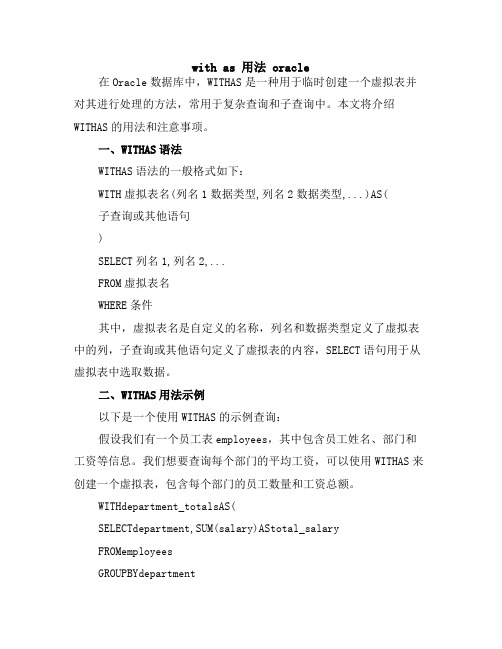
with as 用法 oracle在Oracle数据库中,WITHAS是一种用于临时创建一个虚拟表并对其进行处理的方法,常用于复杂查询和子查询中。
本文将介绍WITHAS的用法和注意事项。
一、WITHAS语法WITHAS语法的一般格式如下:WITH虚拟表名(列名1数据类型,列名2数据类型,...)AS(子查询或其他语句)SELECT列名1,列名2,...FROM虚拟表名WHERE条件其中,虚拟表名是自定义的名称,列名和数据类型定义了虚拟表中的列,子查询或其他语句定义了虚拟表的内容,SELECT语句用于从虚拟表中选取数据。
二、WITHAS用法示例以下是一个使用WITHAS的示例查询:假设我们有一个员工表employees,其中包含员工姓名、部门和工资等信息。
我们想要查询每个部门的平均工资,可以使用WITHAS来创建一个虚拟表,包含每个部门的员工数量和工资总额。
WITHdepartment_totalsAS(SELECTdepartment,SUM(salary)AStotal_salaryFROMemployeesGROUPBYdepartment),avg_salaryAS(SELECTdepartment,AVG(total_salary)ASavg_salaryFROMdepartment_totalsGROUPBYdepartment)SELECT*FROMavg_salary;在上述示例中,我们首先使用子查询GROUPBYdepartment将employees表中的数据分组,并计算每个部门的总工资。
然后,我们使用WITHAS创建了两个虚拟表department_totals和avg_salary,其中department_totals包含每个部门的总工资,avg_salary包含每个部门的平均工资。
最后,我们从avg_salary中选择了所有列。
三、注意事项使用WITHAS时需要注意以下几点:1.虚拟表名必须是唯一的,不能与表名或别名冲突。
oracle存储过程中的with用法

一、概述Oracle数据库提供了存储过程来帮助用户封装一系列SQL语句,以便于简化数据库操作和提高性能。
在存储过程中,常常会使用到WITH 子句来创建临时的查询结果集,以便在存储过程的后续语句中使用。
本文将重点介绍在Oracle存储过程中的WITH用法及注意事项。
二、WITH子句概述1、WITH子句是一种通用表表达式(CTE,Common Table Expression),用于创建临时的命名查询结果集。
WITH子句通常由关键字WITH和一个或多个子查询组成,可以在后续的SQL语句中像使用表一样引用这些临时结果集。
2、在存储过程中使用WITH子句能够提高可读性和维护性,同时还可以优化查询性能。
三、在Oracle存储过程中使用WITH子句的示例在存储过程中使用WITH子句的一般语法如下:```sqlCREATE OR REPLACE PROCEDURE procedure_nameASBEGINWITH temp_table (column1, column2, ...)AS(SELECT column1, column2, ...FROM table_nameWHERE ...)-- 后续的SQL语句可以引用temp_tableEND;```下面是一个具体的示例,假设我们有一个存储过程,需要根据员工的工资水平来进行统计和分析。
```sqlCREATE OR REPLACE PROCEDURE calculate_salary_statistics ASBEGINWITH high_salary_employees (employee_id, employee_name, salary)AS(SELECT employee_id, employee_name, salaryFROM employeesWHERE salary > xxx)SELECT COUNT(*)INTO high_salary_employee_countFROM high_salary_employees;-- 后续可以继续使用high_salary_employees来编写其他逻辑END;```四、在存储过程中使用WITH子句的注意事项1、WITH子句内的查询结果集只在当前的SQL语句中有效,后续的SQL语句需要继续引用它的话,必须在相同的语句块中。
oracle不支持使用with字句,Oracle版WITH语句的使用
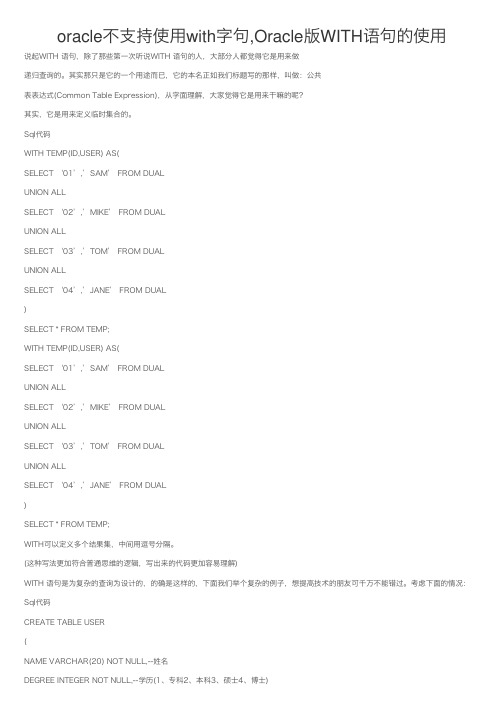
oracle不⽀持使⽤with字句,Oracle版WITH语句的使⽤说起WITH 语句,除了那些第⼀次听说WITH 语句的⼈,⼤部分⼈都觉得它是⽤来做递归查询的。
其实那只是它的⼀个⽤途⽽已,它的本名正如我们标题写的那样,叫做:公共表表达式(Common Table Expression),从字⾯理解,⼤家觉得它是⽤来⼲嘛的呢?其实,它是⽤来定义临时集合的。
Sql代码WITH TEMP(ID,USER) AS(SELECT ‘01’,’SAM’ FROM DUALUNION ALLSELECT ‘02’,’MIKE’ FROM DUALUNION ALLSELECT ‘03’,’TOM’ FROM DUALUNION ALLSELECT ‘04’,’JANE’ FROM DUAL)SELECT * FROM TEMP;WITH TEMP(ID,USER) AS(SELECT ‘01’,’SAM’ FROM DUALUNION ALLSELECT ‘02’,’MIKE’ FROM DUALUNION ALLSELECT ‘03’,’TOM’ FROM DUALUNION ALLSELECT ‘04’,’JANE’ FROM DUAL)SELECT * FROM TEMP;WITH可以定义多个结果集,中间⽤逗号分隔。
(这种写法更加符合普通思维的逻辑,写出来的代码更加容易理解)WITH 语句是为复杂的查询为设计的,的确是这样的,下⾯我们举个复杂的例⼦,想提⾼技术的朋友可千万不能错过。
考虑下⾯的情况:Sql代码CREATE TABLE USER(NAME VARCHAR(20) NOT NULL,--姓名DEGREE INTEGER NOT NULL,--学历(1、专科2、本科3、硕⼠4、博⼠)STARTWORKDATE date NOT NULL,--⼊职时间SALARY1 FLOAT NOT NULL,--基本⼯资SALARY2 FLOAT NOT NULL--奖⾦);CREATE TABLE USER(NAME VARCHAR(20) NOT NULL,--姓名DEGREE INTEGER NOT NULL,--学历(1、专科2、本科3、硕⼠4、博⼠)STARTWORKDATE date NOT NULL,--⼊职时间SALARY1 FLOAT NOT NULL,--基本⼯资SALARY2 FLOAT NOT NULL--奖⾦);假设现在让你查询⼀下那些1、学历是硕⼠或博⼠2、学历相同,⼊职年份也相同,但是⼯资(基本⼯资+奖⾦)却⽐相同条件员⼯的平均⼯资低的员⼯。
oracle with的用法
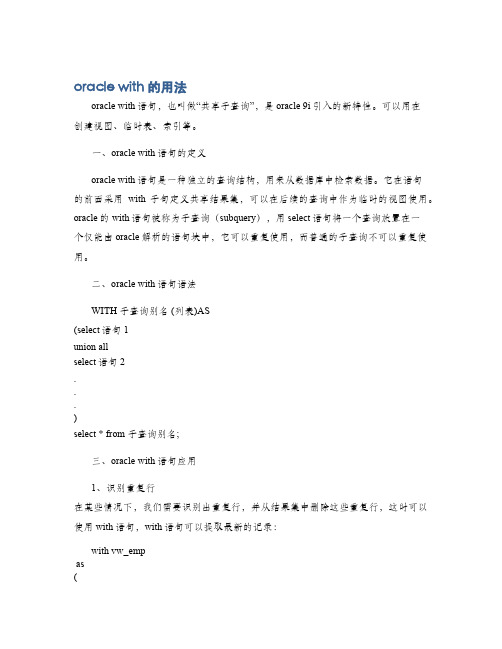
oracle with的用法oracle with语句,也叫做“共享子查询”,是oracle 9i引入的新特性。
可以用在创建视图、临时表、索引等。
一、oracle with语句的定义oracle with语句是一种独立的查询结构,用来从数据库中检索数据。
它在语句的前面采用with子句定义共享结果集,可以在后续的查询中作为临时的视图使用。
oracle的with语句被称为子查询(subquery),用select语句将一个查询放置在一个仅能由oracle解析的语句块中,它可以重复使用,而普通的子查询不可以重复使用。
二、oracle with语句语法WITH 子查询别名 (列表)AS(select语句1union allselect语句2...)select * from 子查询别名;三、oracle with语句应用1、识别重复行在某些情况下,我们需要识别出重复行,并从结果集中删除这些重复行,这时可以使用with语句,with语句可以提取最新的记录:with vw_empas(select emp_no, emp_name, dept_id, ROW_NUMBER()OVER(partition by emp_no order by dept_id desc) as seq_nofrom emp)select emp_no, emp_name, dept_idfrom vw_empwhere seq_no=1;2、使用分组函数使用oracle的分组函数时,如果需要过滤掉重复行,可以考虑使用with语句,而不是在查询中使用group by子句。
with vw_emp as(select emp_no, dept_no, sum(salary) over(partition by emp_no) as total_salaryfrom emp)select * from vw_empwhere total_salary>10000;3、加入计算的逻辑行有时候,我们可以用with语句将一些比较复杂的逻辑以语句的形式写出来,并将它们加入到查询中,以便使查询更加清晰。
oracle 多段with as用法
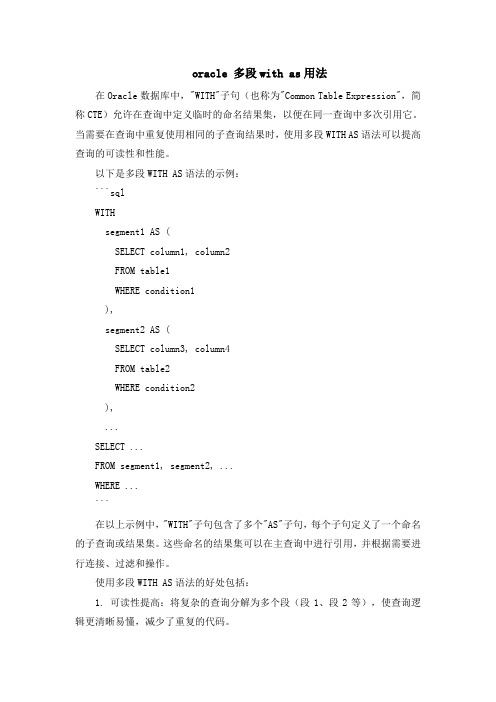
oracle 多段with as用法在Oracle数据库中,"WITH"子句(也称为"Common Table Expression",简称CTE)允许在查询中定义临时的命名结果集,以便在同一查询中多次引用它。
当需要在查询中重复使用相同的子查询结果时,使用多段WITH AS语法可以提高查询的可读性和性能。
以下是多段WITH AS语法的示例:```sqlWITHsegment1 AS (SELECT column1, column2FROM table1WHERE condition1),segment2 AS (SELECT column3, column4FROM table2WHERE condition2),...SELECT ...FROM segment1, segment2, ...WHERE ...```在以上示例中,"WITH"子句包含了多个"AS"子句,每个子句定义了一个命名的子查询或结果集。
这些命名的结果集可以在主查询中进行引用,并根据需要进行连接、过滤和操作。
使用多段WITH AS语法的好处包括:1. 可读性提高:将复杂的查询分解为多个段(段1、段2等),使查询逻辑更清晰易懂,减少了重复的代码。
2. 代码复用:可以在查询中多次引用相同的子查询结果,避免了重复计算。
3. 性能优化:对于大型查询,可以通过定义多段WITH AS子句来优化查询执行计划,提高查询性能。
需要注意的是,多段WITH AS语法的子查询是按照定义的顺序依次执行的,后续的子查询可以引用前面已经定义过的子查询结果。
在主查询中引用子查询结果时,可以直接使用子查询的名称。
总之,Oracle数据库中的多段WITH AS语法允许在同一查询中定义和引用多个命名的子查询结果集,提高了查询的可读性和性能。
通过合理使用多段WITH AS语法,可以更好地组织复杂查询,并优化查询执行计划。
oracle sql with 写法
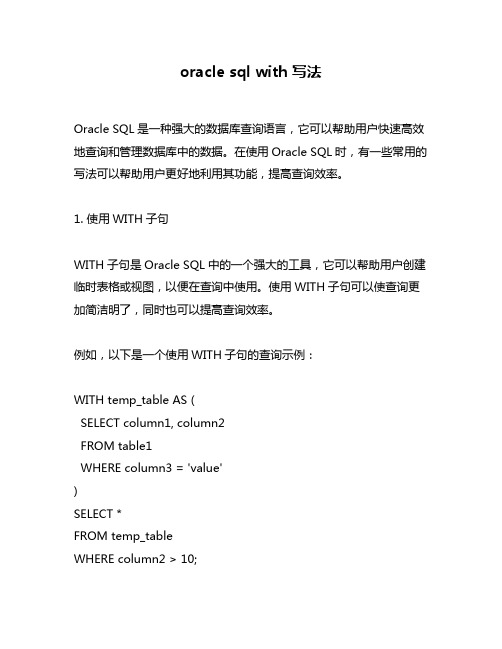
oracle sql with 写法Oracle SQL是一种强大的数据库查询语言,它可以帮助用户快速高效地查询和管理数据库中的数据。
在使用Oracle SQL时,有一些常用的写法可以帮助用户更好地利用其功能,提高查询效率。
1. 使用WITH子句WITH子句是Oracle SQL中的一个强大的工具,它可以帮助用户创建临时表格或视图,以便在查询中使用。
使用WITH子句可以使查询更加简洁明了,同时也可以提高查询效率。
例如,以下是一个使用WITH子句的查询示例:WITH temp_table AS (SELECT column1, column2FROM table1WHERE column3 = 'value')SELECT *FROM temp_tableWHERE column2 > 10;在这个示例中,使用WITH子句创建了一个名为temp_table的临时表格,其中包含了从table1表格中选择column1和column2列,并且column3列的值等于'value'的所有行。
然后,在查询中使用了这个临时表格,筛选出了column2列的值大于10的所有行。
2. 使用子查询除了WITH子句之外,Oracle SQL中还有一种常用的查询方式是子查询。
子查询可以帮助用户在查询中嵌套使用多个SELECT语句,以便更好地筛选和管理数据。
例如,以下是一个使用子查询的查询示例:SELECT *FROM table1WHERE column1 IN (SELECT column1FROM table2WHERE column2 = 'value');在这个示例中,使用了一个子查询来筛选出table2表格中column2列的值等于'value'的所有行,并且返回这些行中的column1列的值。
然后,在主查询中使用了IN运算符,筛选出table1表格中column1列的值在子查询中返回的值集合中的所有行。
oracle中with的用法及用处
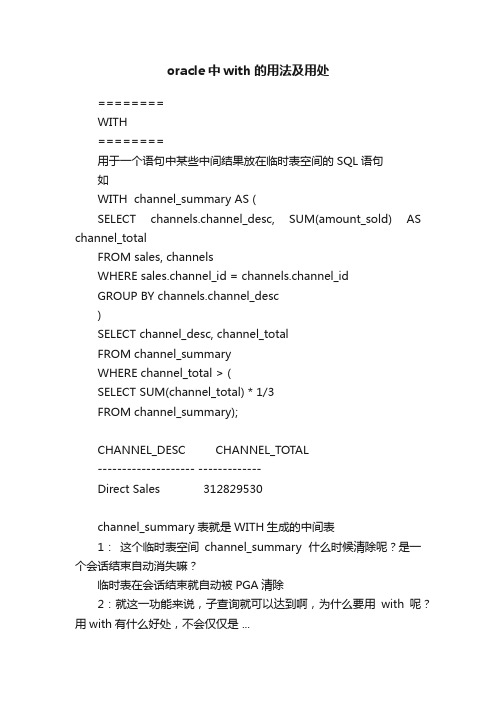
oracle中with的用法及用处========WITH========用于一个语句中某些中间结果放在临时表空间的SQL语句如WITH channel_summary AS (SELECT channels.channel_desc, SUM(amount_sold) AS channel_totalFROM sales, channelsWHERE sales.channel_id = channels.channel_idGROUP BY channels.channel_desc)SELECT channel_desc, channel_totalFROM channel_summaryWHERE channel_total > (SELECT SUM(channel_total) * 1/3FROM channel_summary);CHANNEL_DESC CHANNEL_TOTAL-------------------- -------------Direct Sales 312829530channel_summary表就是WITH生成的中间表1:这个临时表空间channel_summary 什么时候清除呢?是一个会话结束自动消失嘛?临时表在会话结束就自动被PGA清除2:就这一功能来说,子查询就可以达到啊,为什么要用with呢?用with有什么好处,不会仅仅是 ...都能写,但执行计划不同的。
当有多个相似子查询的时候,用with写公共部分,因为子查询结果在内存临时表中,执行效率当然就高啦。
如果你后面需要不止一次地引用这个结果,那么WITH就会大大提高效率。
代码的可读性好。
OracleWith语句语法及示例
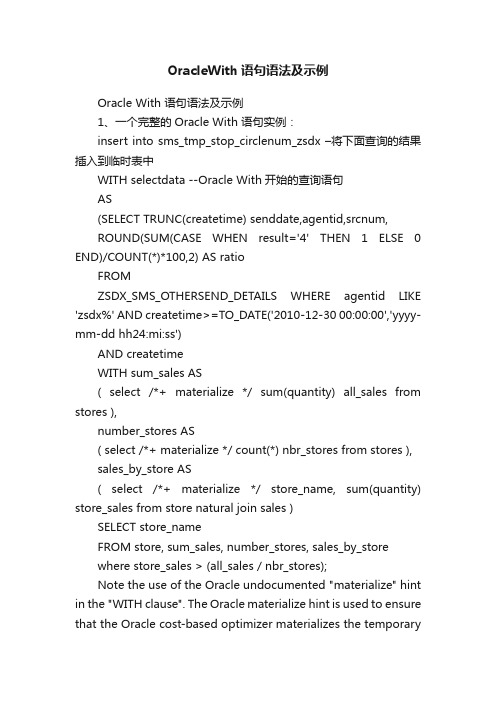
OracleWith语句语法及示例Oracle With 语句语法及示例1、一个完整的Oracle With 语句实例:insert into sms_tmp_stop_circlenum_zsdx –将下面查询的结果插入到临时表中WITH selectdata --Oracle With开始的查询语句AS(SELECT TRUNC(createtime) senddate,agentid,srcnum,ROUND(SUM(CASE WHEN result='4' THEN 1 ELSE 0 END)/COUNT(*)*100,2) AS ratioFROMZSDX_SMS_OTHERSEND_DETAILS WHERE agentid LIKE 'zsdx%' AND createtime>=TO_DATE('2010-12-30 00:00:00','yyyy-mm-dd hh24:mi:ss')AND createtimeWITH sum_sales AS( select /*+ materialize */ sum(quantity) all_sales from stores ),number_stores AS( select /*+ materialize */ count(*) nbr_stores from stores ), sales_by_store AS( select /*+ materialize */ store_name, sum(quantity) store_sales from store natural join sales )SELECT store_nameFROM store, sum_sales, number_stores, sales_by_storewhere store_sales > (all_sales / nbr_stores);Note the use of the Oracle undocumented "materialize" hint in the "WITH clause". The Oracle materialize hint is used to ensure that the Oracle cost-based optimizer materializes the temporarytables that are created inside the "WITH" clause. This is not necessary in Oracle10g, but it helps ensure that the tables are only created one time.It should be noted that the "WITH clause" does not yet fully-functional within Oracle SQL and it does not yet support the use of "WITH clause" replacement for "CONNECT BY" when performing recursive queries.To see how the "WITH clause" is used in ANSI SQL-99 syntax, here is an excerpt from Jonathan Gennick's great work "Understanding the WITH Clause" showing the use of the SQL-99 "WITH clause" to traverse a recursive bill-of-materials hierarchyThe SQL-99 "WITH clause" is very confusing at first because the SQL statement does not begin with the word SELECT. Instead, we use the "WITH clause" to start our SQL query, defining the aggregations, which can then be named in the main query as if they were "real" tables:WITHsubquery_nameAS(the aggregation SQL statement)SELECT(query naming subquery_name);Retuning to our oversimplified example, let's replace the temporary tables with the SQL "WITH" clause":Link:/doc/0b16980966.html,/t_with_clause.htm Improving Query Performance with the SQL WITH ClauseOracle9i significantly enhances both the functionality and performance of SQL to address the requirements of businessintelligence queries. The SELECT statement's WITH clause, introduced in Oracle9i, provides powerful new syntax for enhancing query performance. It optimizes query speed by eliminating redundant processing in complex queries.Consider a lengthy query which has multiple references to a single subquery block. Processing subquery blocks can be costly, so recomputing a block every time it is referenced in the SELECT statement is highly inefficient. The WITH clause enables a SELECT statement to define the subquery block at the start of the query, process the block just once, label the results, and then refer to the results multiple times.The WITH clause, formally known as the subquery factoring clause, is part of the SQL-99 standard. The clause precedes the SELECT statement of a query and starts with the keyword "WITH." The WITH is followed by the subquery definition and a label for the result set. The query below shows a basic example of the clause:WITH channel_summary AS( SELECT channels.channel_desc,SUM(amount_sold) AS channel_totalFROM sales, channelsWHERE sales.channel_id = channels.channel_idGROUP BY channels.channel_desc )SELECT channel_desc, channel_totalFROM channel_summaryWHERE channel_total >( SELECT SUM(channel_total) * 1/3FROM channel_summary );This query uses the WITH clause to calculate the sum of sales for each sales channel and label the results as channel_summary.Then it checks each channel's sales total to see if any channel's sales are greater than one third of the total sales. By using the new clause, the channel_summary data is calculated just once, avoiding an extra scan through the large sales table.Although the primary purpose of the WITH clause is performance improvement, it also makes queries easier to read, write and maintain. Rather than duplicating a large block repeatedly through a SELECT statement, the block is localized at the very start of the query. Note that the clause can define multiple subquery blocks at the start of a SELECT statement: when several blocks are defined at the start, the query text is greatly simplified and its speed vastly improved.The SQL WITH clause in Oracle9i significantly improves performance for complex business intelligence queries. Together with the many other SQL enhancements in Oracle9i, the WITH clause extends Oracle's leadership in business intelligence.。
oraclewith子句
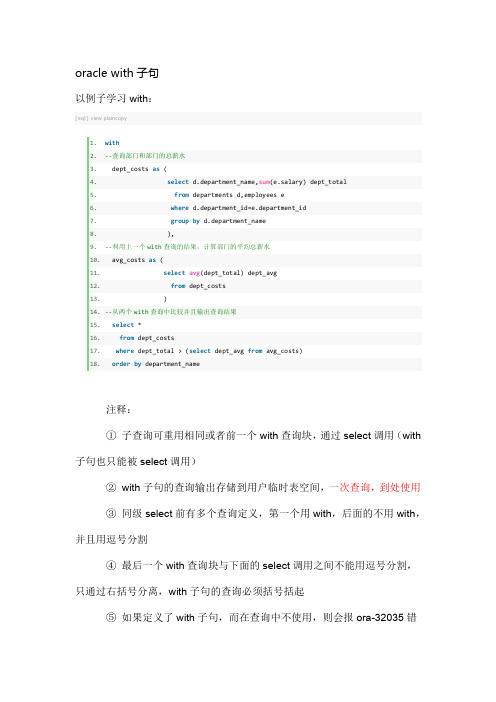
oracle with子句以例子学习with:[sql]view plaincopy1.with2.--查询部门和部门的总薪水3. dept_costs as (4.select d.department_name,sum(e.salary) dept_total5.from departments d,employees e6.where d.department_id=e.department_id7.group by d.department_name8. ),9.--利用上一个with查询的结果,计算部门的平均总薪水10. avg_costs as (11.select avg(dept_total) dept_avg12.from dept_costs13. )14.--从两个with查询中比较并且输出查询结果15.select *16.from dept_costs17.where dept_total > (select dept_avg from avg_costs)18.order by department_name注释:①子查询可重用相同或者前一个with查询块,通过select调用(with 子句也只能被select调用)②with子句的查询输出存储到用户临时表空间,一次查询,到处使用③同级select前有多个查询定义,第一个用with,后面的不用with,并且用逗号分割④最后一个with查询块与下面的select调用之间不能用逗号分割,只通过右括号分离,with子句的查询必须括号括起⑤如果定义了with子句,而在查询中不使用,则会报ora-32035错误,只要后面有引用的即可,不一定在select调用,在后with查询块引用也是可以的⑥前面的with子句定义的查询在后面的with子句中可以使用,但是一个with子句内部不能嵌套with子句⑦with查询的结果列有别名,引用时候必须使用别名或者*再来看with的语法㈠as和select中的括号不能省略㈡同级别select调用,with只能定义一次,多个用逗号分隔,但最后一个with子查询与下面的实际查询之间没有逗号with子句的优点①with子句有可能会改变执行计划②with子查询只执行一次,将结果存储在用户的临时表空间,可多次引用,增加性能③sql的可读性较强案例:Ⅰ一般使用方式[sql]view plaincopy1.with2.--查询销售部门员工的姓名3. saler_name as (4.select department_id from departments where department_name='SALES'order by department_id5. )6.select last_name,first_name7.from employees e8.where department_id in (select * from saler_name)注释:使用with子句,可以在复杂的查询中预先定义好一个结果集,然后在查询中反复使用,不使用会报错。
Oracle中with关键字的使用
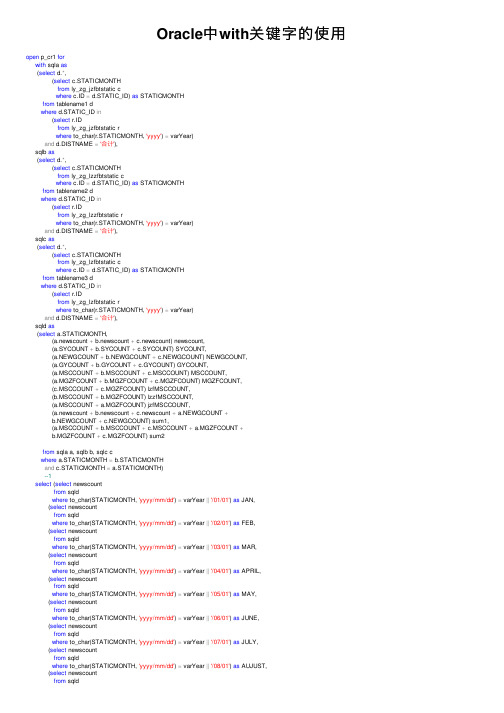
Oracle中with关键字的使⽤open p_cr1 forwith sqla as(select d.*,(select c.STATICMONTHfrom ly_zg_jzfbtstatic cwhere c.ID = d.STATIC_ID) as STATICMONTHfrom tablename1 dwhere d.STATIC_ID in(select r.IDfrom ly_zg_jzfbtstatic rwhere to_char(r.STATICMONTH, 'yyyy') = varYear)and d.DISTNAME ='合计'),sqlb as(select d.*,(select c.STATICMONTHfrom ly_zg_lzzfbtstatic cwhere c.ID = d.STATIC_ID) as STATICMONTHfrom tablename2 dwhere d.STATIC_ID in(select r.IDfrom ly_zg_lzzfbtstatic rwhere to_char(r.STATICMONTH, 'yyyy') = varYear)and d.DISTNAME ='合计'),sqlc as(select d.*,(select c.STATICMONTHfrom ly_zg_lzfbtstatic cwhere c.ID = d.STATIC_ID) as STATICMONTHfrom tablename3 dwhere d.STATIC_ID in(select r.IDfrom ly_zg_lzfbtstatic rwhere to_char(r.STATICMONTH, 'yyyy') = varYear)and d.DISTNAME ='合计'),sqld as(select a.STATICMONTH,(a.newscount + b.newscount + c.newscount) newscount,(a.SYCOUNT + b.SYCOUNT + c.SYCOUNT) SYCOUNT,(a.NEWGCOUNT + b.NEWGCOUNT + c.NEWGCOUNT) NEWGCOUNT,(a.GYCOUNT + b.GYCOUNT + c.GYCOUNT) GYCOUNT,(a.MSCCOUNT + b.MSCCOUNT + c.MSCCOUNT) MSCCOUNT,(a.MGZFCOUNT + b.MGZFCOUNT + c.MGZFCOUNT) MGZFCOUNT,(c.MSCCOUNT + c.MGZFCOUNT) lzfMSCCOUNT,(b.MSCCOUNT + b.MGZFCOUNT) lzzfMSCCOUNT,(a.MSCCOUNT + a.MGZFCOUNT) jzfMSCCOUNT,(a.newscount + b.newscount + c.newscount + a.NEWGCOUNT +b.NEWGCOUNT +c.NEWGCOUNT) sum1,(a.MSCCOUNT + b.MSCCOUNT + c.MSCCOUNT + a.MGZFCOUNT +b.MGZFCOUNT +c.MGZFCOUNT) sum2from sqla a, sqlb b, sqlc cwhere a.STATICMONTH = b.STATICMONTHand c.STATICMONTH = a.STATICMONTH)--1select (select newscountfrom sqldwhere to_char(STATICMONTH, 'yyyy/mm/dd') = varYear ||'/01/01') as JAN,(select newscountfrom sqldwhere to_char(STATICMONTH, 'yyyy/mm/dd') = varYear ||'/02/01') as FEB,(select newscountfrom sqldwhere to_char(STATICMONTH, 'yyyy/mm/dd') = varYear ||'/03/01') as MAR,(select newscountfrom sqldwhere to_char(STATICMONTH, 'yyyy/mm/dd') = varYear ||'/04/01') as APRIL,(select newscountfrom sqldwhere to_char(STATICMONTH, 'yyyy/mm/dd') = varYear ||'/05/01') as MAY,(select newscountfrom sqldwhere to_char(STATICMONTH, 'yyyy/mm/dd') = varYear ||'/06/01') as JUNE,(select newscountfrom sqldwhere to_char(STATICMONTH, 'yyyy/mm/dd') = varYear ||'/07/01') as JULY,(select newscountfrom sqldwhere to_char(STATICMONTH, 'yyyy/mm/dd') = varYear ||'/08/01') as AUJUST,(select newscountfrom sqldwhere to_char(STATICMONTH, 'yyyy/mm/dd') = varYear ||'/09/01') as SEPT,(select newscountfrom sqldwhere to_char(STATICMONTH, 'yyyy/mm/dd') = varYear ||'/10/01') as OCT,(select newscountfrom sqldwhere to_char(STATICMONTH, 'yyyy/mm/dd') = varYear ||'/11/01') as NOV,(select newscountfrom sqldwhere to_char(STATICMONTH, 'yyyy/mm/dd') = varYear ||'/12/01') as DECEfrom dualunion all--2select null as JAN,null as FEB,null as MAR,null as APRIL,null as MAY,null as JUNE,null as JULY,null as AUGUST,null as SEPT,null as OCT,null as NOV,null as DECEfrom dualunion all--3select (select SYCOUNTfrom sqldwhere to_char(STATICMONTH, 'yyyy/mm/dd') = varYear ||'/01/01') as JAN,(select SYCOUNTfrom sqldwhere to_char(STATICMONTH, 'yyyy/mm/dd') = varYear ||'/02/01') as FEB,(select SYCOUNTfrom sqldwhere to_char(STATICMONTH, 'yyyy/mm/dd') = varYear ||'/03/01') as MAR,(select SYCOUNTfrom sqldwhere to_char(STATICMONTH, 'yyyy/mm/dd') = varYear ||'/04/01') as APRIL,(select SYCOUNTfrom sqldwhere to_char(STATICMONTH, 'yyyy/mm/dd') = varYear ||'/05/01') as MAY,(select SYCOUNTfrom sqldwhere to_char(STATICMONTH, 'yyyy/mm/dd') = varYear ||'/06/01') as JUNE,(select SYCOUNTfrom sqldwhere to_char(STATICMONTH, 'yyyy/mm/dd') = varYear ||'/07/01') as JULY,(select SYCOUNTfrom sqldwhere to_char(STATICMONTH, 'yyyy/mm/dd') = varYear ||'/08/01') as AUJUST,(select SYCOUNTfrom sqldwhere to_char(STATICMONTH, 'yyyy/mm/dd') = varYear ||'/09/01') as SEPT,(select SYCOUNTfrom sqldwhere to_char(STATICMONTH, 'yyyy/mm/dd') = varYear ||'/10/01') as OCT,(select SYCOUNTfrom sqldwhere to_char(STATICMONTH, 'yyyy/mm/dd') = varYear ||'/11/01') as NOV,(select SYCOUNTfrom sqldwhere to_char(STATICMONTH, 'yyyy/mm/dd') = varYear ||'/12/01') as DECEfrom dual;当现有的表不满⾜我们写如意sql,或者是根据现有的表写出如意sql太过复杂,所以Oracle为我们提出了with关键字,帮我们提供了很⼤的帮助住,with后⾯的虚拟表必须⽤圆括号包起来,并且括号后⾯必须紧连接select关键字并且⽤union all 连接的⾏中,每⾏中的列数据类型必须⼀致,注:null兼容任意数据类型ye。
oracle的with语法
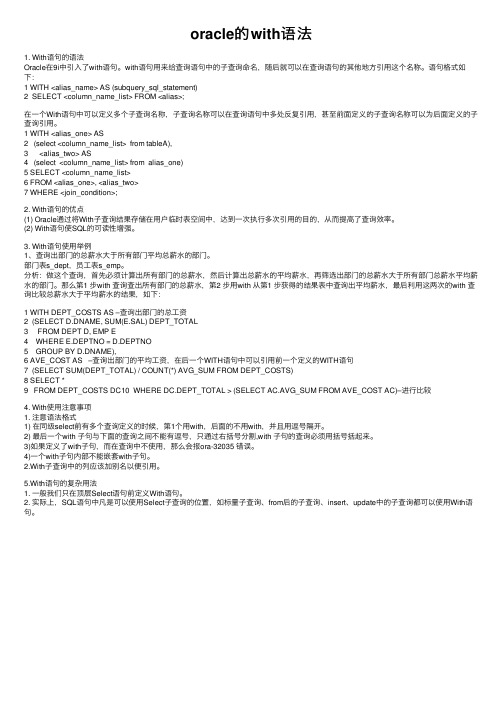
oracle的with语法1. With语句的语法Oracle在9i中引⼊了with语句。
with语句⽤来给查询语句中的⼦查询命名,随后就可以在查询语句的其他地⽅引⽤这个名称。
语句格式如下:1 WITH <alias_name> AS (subquery_sql_statement)2 SELECT <column_name_list> FROM <alias>;在⼀个With语句中可以定义多个⼦查询名称,⼦查询名称可以在查询语句中多处反复引⽤,甚⾄前⾯定义的⼦查询名称可以为后⾯定义的⼦查询引⽤。
1 WITH <alias_one> AS2 (select <column_name_list> from tableA),3 <alias_two> AS4 (select <column_name_list> from alias_one)5 SELECT <column_name_list>6 FROM <alias_one>, <alias_two>7 WHERE <join_condition>;2. With语句的优点(1) Oracle通过将With⼦查询结果存储在⽤户临时表空间中,达到⼀次执⾏多次引⽤的⽬的,从⽽提⾼了查询效率。
(2) With语句使SQL的可读性增强。
3. With语句使⽤举例1、查询出部门的总薪⽔⼤于所有部门平均总薪⽔的部门。
部门表s_dept,员⼯表s_emp。
分析:做这个查询,⾸先必须计算出所有部门的总薪⽔,然后计算出总薪⽔的平均薪⽔,再筛选出部门的总薪⽔⼤于所有部门总薪⽔平均薪⽔的部门。
那么第1 步with 查询查出所有部门的总薪⽔,第2 步⽤with 从第1 步获得的结果表中查询出平均薪⽔,最后利⽤这两次的with 查询⽐较总薪⽔⼤于平均薪⽔的结果,如下:1 WITH DEPT_COSTS AS –查询出部门的总⼯资2 (SELECT D.DNAME, SUM(E.SAL) DEPT_TOTAL3 FROM DEPT D, EMP E4 WHERE E.DEPTNO = D.DEPTNO5 GROUP BY D.DNAME),6 AVE_COST AS –查询出部门的平均⼯资,在后⼀个WITH语句中可以引⽤前⼀个定义的WITH语句7 (SELECT SUM(DEPT_TOTAL) / COUNT(*) AVG_SUM FROM DEPT_COSTS)8 SELECT *9 FROM DEPT_COSTS DC10 WHERE DC.DEPT_TOTAL > (SELECT AC.AVG_SUM FROM AVE_COST AC)–进⾏⽐较4. With使⽤注意事项1. 注意语法格式1) 在同级select前有多个查询定义的时候,第1个⽤with,后⾯的不⽤with,并且⽤逗号隔开。
with oracle 用法
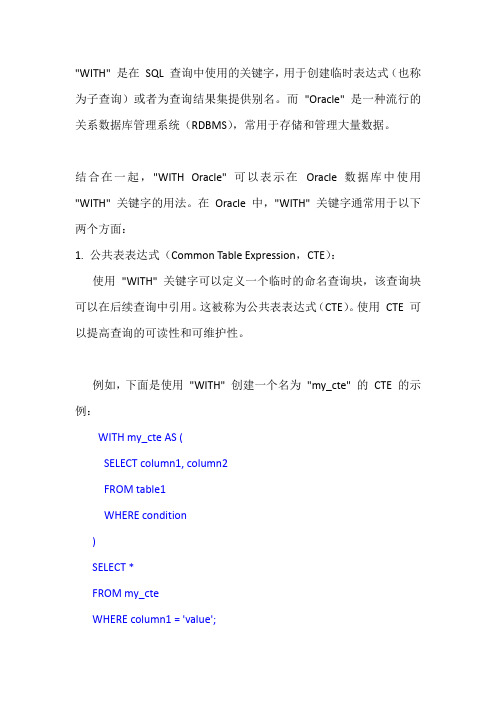
"WITH" 是在SQL 查询中使用的关键字,用于创建临时表达式(也称为子查询)或者为查询结果集提供别名。
而"Oracle" 是一种流行的关系数据库管理系统(RDBMS),常用于存储和管理大量数据。
结合在一起,"WITH Oracle" 可以表示在Oracle 数据库中使用"WITH" 关键字的用法。
在Oracle 中,"WITH" 关键字通常用于以下两个方面:1. 公共表表达式(Common Table Expression,CTE):使用"WITH" 关键字可以定义一个临时的命名查询块,该查询块可以在后续查询中引用。
这被称为公共表表达式(CTE)。
使用CTE 可以提高查询的可读性和可维护性。
例如,下面是使用"WITH" 创建一个名为"my_cte" 的CTE 的示例:WITH my_cte AS (SELECT column1, column2FROM table1WHERE condition)SELECT *FROM my_cteWHERE column1 = 'value';2. 递归查询(Recursive Queries):在Oracle 中,"WITH" 还可以用于创建递归查询,即查询可以自引用并在自身上执行迭代操作。
递归查询通常用于处理具有层次结构或递归关系的数据。
例如,下面是使用"WITH" 创建递归查询的示例:WITH recursive_query (column1, column2) AS (SELECT root_column1, root_column2FROM tableWHERE conditionUNION ALLSELECT child_column1, child_column2FROM tableJOIN recursive_query ON table.parent_id = recursive_query.column1)SELECT *FROM recursive_query;需要注意的是,"WITH" 关键字的用法可以根据具体的查询和数据模型而有所不同。
oracle的with简书
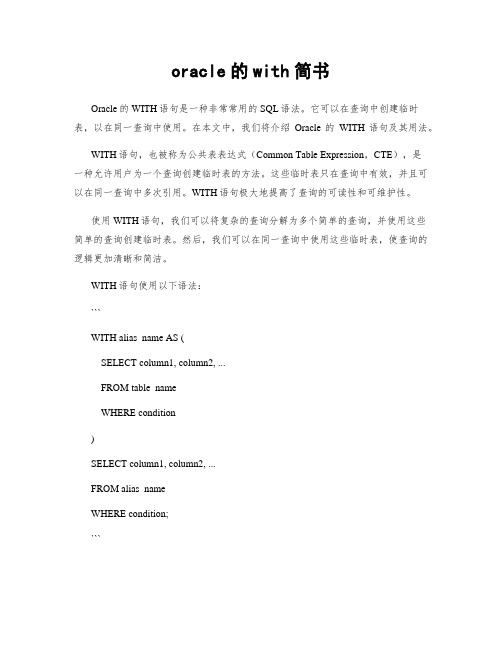
oracle的with简书Oracle的WITH语句是一种非常常用的SQL语法。
它可以在查询中创建临时表,以在同一查询中使用。
在本文中,我们将介绍Oracle的WITH语句及其用法。
WITH语句,也被称为公共表表达式(Common Table Expression,CTE),是一种允许用户为一个查询创建临时表的方法。
这些临时表只在查询中有效,并且可以在同一查询中多次引用。
WITH语句极大地提高了查询的可读性和可维护性。
使用WITH语句,我们可以将复杂的查询分解为多个简单的查询,并使用这些简单的查询创建临时表。
然后,我们可以在同一查询中使用这些临时表,使查询的逻辑更加清晰和简洁。
WITH语句使用以下语法:```WITH alias_name AS (SELECT column1, column2, ...FROM table_nameWHERE condition)SELECT column1, column2, ...FROM alias_nameWHERE condition;```在这个语法中,我们首先使用WITH关键字声明一个临时表的别名。
然后,在AS子句中,我们使用SELECT语句来定义这个临时表的内容。
接下来,在主查询中,我们使用这个临时表的别名来引用这个临时表。
以下是一个使用WITH语句的示例:```WITH employees AS (SELECT employee_id, first_name, last_name, salaryFROM employeesWHERE salary > 5000)SELECT first_name, last_name, salaryFROM employeesWHERE salary > 10000;```在这个示例中,我们首先创建了一个临时表employees,该表包含了工资大于5000的雇员的信息。
然后,在主查询中,我们进一步筛选工资大于10000的雇员,并显示他们的姓名和工资。
with ls as 用法 oracle
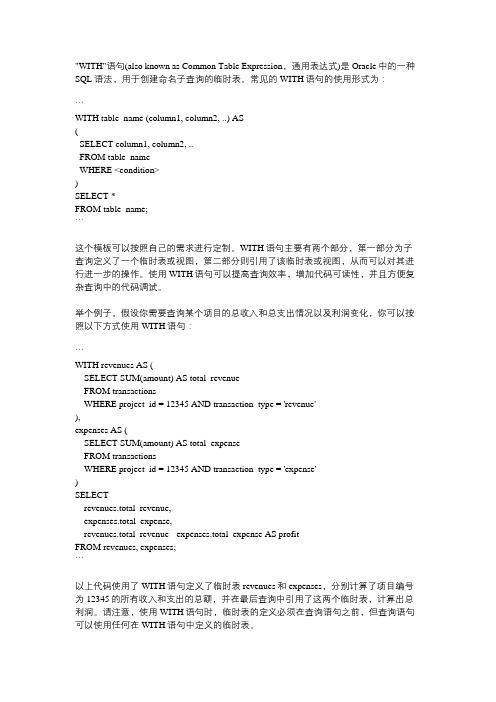
"WITH"语句(also known as Common Table Expression,通用表达式)是Oracle中的一种SQL语法,用于创建命名子查询的临时表。
常见的WITH语句的使用形式为:```WITH table_name (column1, column2, ..) AS(SELECT column1, column2, ..FROM table_nameWHERE <condition>)SELECT *FROM table_name;```这个模板可以按照自己的需求进行定制。
WITH语句主要有两个部分,第一部分为子查询定义了一个临时表或视图,第二部分则引用了该临时表或视图,从而可以对其进行进一步的操作。
使用WITH语句可以提高查询效率,增加代码可读性,并且方便复杂查询中的代码调试。
举个例子,假设你需要查询某个项目的总收入和总支出情况以及利润变化,你可以按照以下方式使用WITH语句:```WITH revenues AS (SELECT SUM(amount) AS total_revenueFROM transactionsWHERE project_id = 12345 AND transaction_type = 'revenue'),expenses AS (SELECT SUM(amount) AS total_expenseFROM transactionsWHERE project_id = 12345 AND transaction_type = 'expense')SELECTrevenues.total_revenue,expenses.total_expense,revenues.total_revenue - expenses.total_expense AS profitFROM revenues, expenses;```以上代码使用了WITH语句定义了临时表revenues和expenses,分别计算了项目编号为12345的所有收入和支出的总额,并在最后查询中引用了这两个临时表,计算出总利润。
oracle 递归查询逻辑
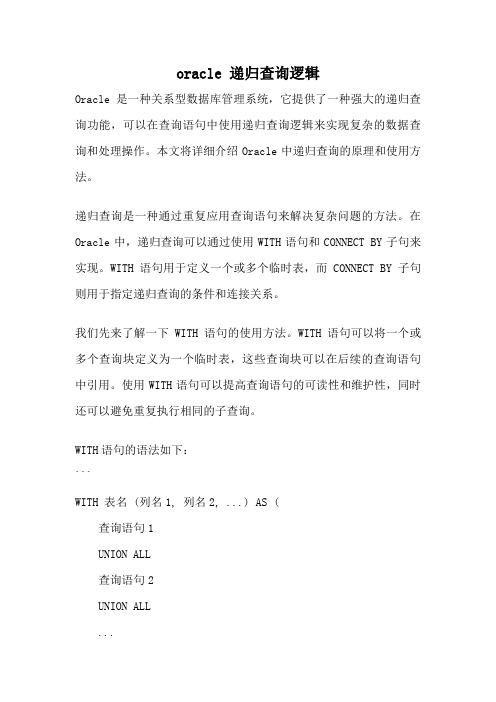
oracle 递归查询逻辑Oracle是一种关系型数据库管理系统,它提供了一种强大的递归查询功能,可以在查询语句中使用递归查询逻辑来实现复杂的数据查询和处理操作。
本文将详细介绍Oracle中递归查询的原理和使用方法。
递归查询是一种通过重复应用查询语句来解决复杂问题的方法。
在Oracle中,递归查询可以通过使用WITH语句和CONNECT BY子句来实现。
WITH语句用于定义一个或多个临时表,而CONNECT BY子句则用于指定递归查询的条件和连接关系。
我们先来了解一下WITH语句的使用方法。
WITH语句可以将一个或多个查询块定义为一个临时表,这些查询块可以在后续的查询语句中引用。
使用WITH语句可以提高查询语句的可读性和维护性,同时还可以避免重复执行相同的子查询。
WITH语句的语法如下:```WITH 表名 (列名1, 列名2, ...) AS (查询语句1UNION ALL查询语句2UNION ALL...查询语句n)```其中,表名是临时表的名称,列名1、列名2等是临时表的列名,查询语句1、查询语句2等是定义临时表的查询语句。
接下来,我们来看一下CONNECT BY子句的使用方法。
CONNECT BY 子句用于指定递归查询的条件和连接关系。
在递归查询中,每个查询块都必须包含一个起始条件和一个递归条件,起始条件用于指定递归查询的起始节点,而递归条件则用于指定递归查询的连接关系。
CONNECT BY子句的语法如下:```SELECT 列名1, 列名2, ...FROM 表名START WITH 起始条件CONNECT BY 递归条件```其中,列名1、列名2等是要查询的列名,表名是要查询的表名,起始条件用于指定递归查询的起始节点,递归条件用于指定递归查询的连接关系。
在使用递归查询时,我们需要注意一些重要的事项。
首先,递归查询必须包含一个终止条件,以避免无限递归。
其次,递归查询可能会导致性能问题,特别是在处理大量数据时。
- 1、下载文档前请自行甄别文档内容的完整性,平台不提供额外的编辑、内容补充、找答案等附加服务。
- 2、"仅部分预览"的文档,不可在线预览部分如存在完整性等问题,可反馈申请退款(可完整预览的文档不适用该条件!)。
- 3、如文档侵犯您的权益,请联系客服反馈,我们会尽快为您处理(人工客服工作时间:9:00-18:30)。
Oracle With 语句语法及示例1、一个完整的Oracle With 语句实例:insert into sms_tmp_stop_circlenum_zsdx –将下面查询的结果插入到临时表中WITH selectdata --Oracle With开始的查询语句AS(SELECT TRUNC(createtime) senddate,agentid,srcnum,ROUND(SUM(CASE WHEN result='4' THEN 1 ELSE 0 END)/COUNT(*)*100,2) AS ratioFROMZSDX_SMS_OTHERSEND_DETAILS WHERE agentid LIKE 'zsdx%' AND createtime>=TO_DATE('2010-12-30 00:00:00','yyyy-mm-dd hh24:mi:ss')AND createtime<TO_DATE('2010-12-30 23:59:59','yyyy-mm-dd hh24:mi:ss') GROUP BY TRUNC(createtime),srcnum,agentid)SELECTa2.senddate,a1.agentid,a1.srcnum,a1.passwd,a1.ACCOUNT,a1.createtime,a2.rati o||'%' AS 当天状态返回失败比率,SYSDATE AS 运维停用时间,'李兴宗' AS 停用操作FROM(SELECT agentid,srcnum,passwd,ACCOUNT,createtime FROM ZSDX_SMS_CIRCLENUM WHERE srcnum IN(SELECT srcnum FROMselectdata WHERE ratio>=100) )a1,(SELECT srcnum,ratio,senddate FROMselectdata WHERE ratio>=100) a2WHERE a1.srcnum=a2.srcnum2、详解:Starting in Oracle9i release 2 we see an incorporation of the SQL-99 "WITH clause", a tool for materializing subqueries to save Oracle from having to re-compute them multiple times.The SQL "WITH clause" is very similar to the use of Global temporary tables (GTT), a technique that is often used to improve query speed for complex subqueries. Here are some important notes about the Oracle "WITH clause":? The SQL "WITH clause" only works on Oracle 9i release 2 and beyond.? Formally, the "WITH clause" is called subquery factoring? The SQL "WITH clause" is used when a subquery is executed multiple times ? Also useful for recursive queries (SQL-99, but not Oracle SQL)To keep it simple, the following example only references the aggregations once, where the SQL "WITH clause" is normally used when an aggregation is referenced multiple times in a query.We can also use the SQL-99 "WITH clause" instead of temporary tables. The Oracle SQL "WITH clause" will compute the aggregation once, give it a name, and allow us to reference it (maybe multiple times), later in the query.The SQL-99 "WITH clause" is very confusing at first because the SQL statement does not begin with the word SELECT. Instead, we use the "WITH clause" to start our SQL query, defining the aggregations, which can then be named in the main query as if they were "real" tables:WITHsubquery_nameAS(the aggregation SQL statement)SELECT(query naming subquery_name);Retuning to our oversimplified example, let's replace the temporary tables with the SQL "WITH clause" (Note: You may find a faster execution plan by using Global Temporary tables, depending on your release of Oracle):WITH sum_sales AS( select /*+ materialize */ sum(quantity) all_sales from stores ),number_stores AS( select /*+ materialize */ count(*) nbr_stores from stores ),sales_by_store AS( select /*+ materialize */ store_name, sum(quantity) store_sales from store natural join sales )SELECT store_nameFROM store, sum_sales, number_stores, sales_by_storewhere store_sales > (all_sales / nbr_stores);Note the use of the Oracle undocumented "materialize" hint in the "WITH clause". The Oracle materialize hint is used to ensure that the Oracle cost-based optimizer materializes the temporary tables that are created inside the "WITH" clause. This is not necessary in Oracle10g, but it helps ensure that the tables are only created one time.It should be noted that the "WITH clause" does not yet fully-functional within Oracle SQL and it does not yet support the use of "WITH clause" replacement for "CONNECT BY" when performing recursive queries.To see how the "WITH clause" is used in ANSI SQL-99 syntax, here is an excerpt from Jonathan Gennick's great work "Understanding the WITH Clause" showing the use of the SQL-99 "WITH clause" to traverse a recursive bill-of-materials hierarchyThe SQL-99 "WITH clause" is very confusing at first because the SQL statement does not begin with the word SELECT. Instead, we use the "WITH clause" to start our SQL query, defining the aggregations, which can then be named in the main query as if they were "real" tables:WITHsubquery_nameAS(the aggregation SQL statement)SELECT(query naming subquery_name);Retuning to our oversimplified example, let's replace the temporary tables with the SQL "WITH" clause":Link:/t_with_clause.htmImproving Query Performance with the SQL WITH ClauseOracle9i significantly enhances both the functionality and performance of SQL to address the requirements of business intelligence queries. The SELECT statement's WITH clause, introduced in Oracle9i, provides powerful new syntax for enhancing query performance. It optimizes query speed by eliminating redundant processing in complex queries.Consider a lengthy query which has multiple references to a single subquery block. Processing subquery blocks can be costly, so recomputing a block every time it is referenced in the SELECT statement is highly inefficient. The WITH clause enables a SELECT statement to define the subquery block at the start of the query, process the block just once, label the results, and then refer to the results multiple times.The WITH clause, formally known as the subquery factoring clause, is part of the SQL-99 standard. The clause precedes the SELECT statement of a query and starts with the keyword "WITH." The WITH is followed by the subquery definition and a label for the result set. The query below shows a basic example of the clause:WITH channel_summary AS( SELECT channels.channel_desc,SUM(amount_sold) AS channel_totalFROM sales, channelsWHERE sales.channel_id = channels.channel_idGROUP BY channels.channel_desc )SELECT channel_desc, channel_totalFROM channel_summaryWHERE channel_total >( SELECT SUM(channel_total) * 1/3FROM channel_summary );This query uses the WITH clause to calculate the sum of sales for each sales channel and label the results as channel_summary. Then it checks each channel's sales total to see if any channel's sales are greater than one third of the total sales. By using the new clause, the channel_summary data is calculated just once, avoiding an extra scan through the large sales table.Although the primary purpose of the WITH clause is performance improvement, it also makes queries easier to read, write and maintain. Rather than duplicating a large block repeatedly through a SELECT statement, the block is localized at the very start of the query. Note that the clause can define multiple subquery blocks at the start of a SELECT statement: when several blocks are defined at the start, the query text is greatly simplified and its speed vastly improved.The SQL WITH clause in Oracle9i significantly improves performance for complex business intelligence queries. Together with the many other SQL enhancements in Oracle9i, the WITH clause extends Oracle's leadership in business intelligence.。
